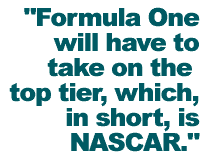

| He Who Holds the Purse Strings |
|
|
| Paul Rushworth, England |
 Formula One has for a long time now been the sport of the affluent. Be it the Yen, Franc,
Dollar, Pound or Lira, money is the fuel which keeps the wheels of Formula One
revolving. FOCA would have us consider that every race is watched by 300,000,000
people, each clambering for the view of 22 stylishly liveried "automobiles designed solely
for speed races on circuits". The situation has never been so bright. Or has it?
Formula One has for a long time now been the sport of the affluent. Be it the Yen, Franc,
Dollar, Pound or Lira, money is the fuel which keeps the wheels of Formula One
revolving. FOCA would have us consider that every race is watched by 300,000,000
people, each clambering for the view of 22 stylishly liveried "automobiles designed solely
for speed races on circuits". The situation has never been so bright. Or has it?
In the build up to the Brazilian Grand Prix, Lola Grand Prix announced that they would not be competing Easter weekend. Only hours after this announcement came the notice that Lola's 1997 Grand Prix program had been suspended indefinitely. For this incidentally, Eric Broadley must be congratulated. Formula One has been littered with many teams forced to the financial red line -- and pushed over. To pull out now without leaving a trail of hungry creditors is a responsible and credible action. More importantly, it has safeguarded Lola Grand Prix for the future.
Just how hard is it for the borderline teams to gain access to the almighty sponsorship dollar? The funding arrangement for Lola is thought to have been arranged along these lines.
Prospective or existing Mastercard clients were offered the opportunity to join the Mastercard Lola team. Not quite in the sense of Lavaggi slapping a platinum card down in exchange for a few laps at Estoril, but membership to the Mastercard Lola team which gave access to test days, functions and social opportunities to meet both the team and drivers. In exchange for this, every time a Mastercard Lola team member waved 4 inches of plastic at thousands of retailers worldwide, a percentage of each sale would be credited to the Huntingdon based team.
An innovative concept perhaps, but these days such deals are the norm for those who populate and disappear from the less prominent end of the pit lane.
Simtek Grand Prix had such a deal in place for the 1995 season. In exchange for prominent placing on the S195's airbox was not cold hard currency, rather air time on MTV. This advertising space was then sold on to the other Simtek sponsors in exchange for hard currency. Likewise, Parmalat's 1995 sponsorship deal with Pedro Diniz, and ultimately Forti Corse, involved the prominent placing of Parmalat products in a chain of Brazilian supermarkets owned by Diniz's father.
The problem with raising sponsorship, most especially for the English teams, is a market over-saturated with Formula One. Witness to the fact the new Stewart concern. Study one as closely as you possibly can and you will see it is devoid of English companies. If it wasn't for the Racing Stewart Tartan that wraps boldly around the sides of the SF-1 (and every other Stewart-run car), the cars are devoid of anything from the United Kingdom, bar the technology which sits underneath.
Increasingly, the focus of the Formula One marketing machine has to move away from the safe shores of Europe, and across the Atlantic to the untapped market of the world's biggest consumer haven: The United States of America.
Formula One has had many forays into the volatile American market, none of which have been particularly successful. Detroit, Dallas, and Phoenix all had short lives, and did little to promote the sport in the United States. Racing did excel in Phoenix, of course. An ostrich race shortly after the 1991 GP drew a much higher crowd than the GP ever managed in its 3 year stay in Arizona.
Formula One's target to beat is not ostriches or even CART in the United States. Formula One will have to take on the top tier, which, in short, is NASCAR. Many people outside of the U.S have difficulty in understanding just how big NASCAR is. Compared to NASCAR, CART has all the popularity in North America as Formula Vauxhall Jr. has in the UK. As Atlas F1 Editor, Bill Doolittle, accounted in his view of the NASCAR series, the amount of money that flows through the NASCAR series puts Formula One to shame. As Formula One has had no success at winning the hearts or minds of the American motor sport fan, it must target itself at those who control the purse strings.
The proposed public floating of FOCA, the organization that controls the television rights to Formula One, would seem to have two benefits. The sale of a percentage of FOCA will raise needed capital for the expansion of digital coverage around the world, which is undoubtedly going to revolutionize the way you and I view motor sport. What is critical is where it being sold. Both the London and New York Stock Markets are listed as the expected locations for such a sale. The penetration of North America which failed by the sport is now seriously possible by commercial means. Investment in FOCA is undoubtedly a secure option, which many American financial concerns are bound to express interest in, and should serve as an avenue for Formula One as a whole to raising their profile within the American Market.
Whether it will lead to long term involvement in America for Formula One, is the question that remains to be answered. For the long term growth of Formula One, the answer has to be yes.